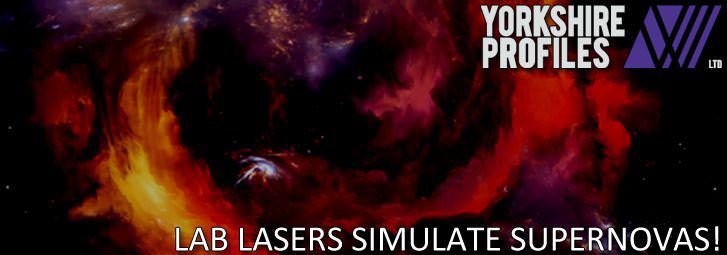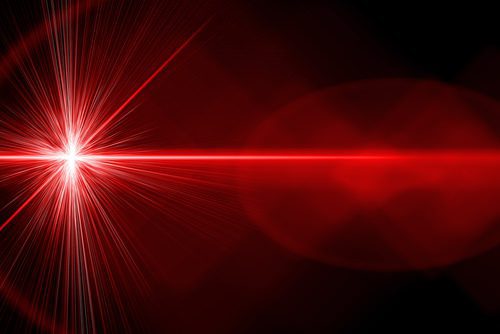
Here at Yorkshire Profiles, a large proportion of our bread and butter, so to speak, comes from offering our wide range of laser cutting services to our numerous clients. We’re masters of our trade as well as being thought-leaders, and we don’t just achieve this through our fantastic proficiency – it’s our passion that sets us apart. Our passion for all things lasers!
We always try to keep a look out for things going on in the world of laser technology – even if it’s not going to directly affect the way in which we conduct our business and provide our services.
We recently came across an article which reported that a group of researchers have successfully simulated supernova explosions using highly advanced and powerful lasers.
What is a supernova explosion?
Many of us have heard the word ‘supernova’ – in fact, most of us probably have. But what is it? “Isn’t that part of an Oasis song title?” you may be asking – and the answer is yes. “Champagne Supernova” is a song from their album (What’s the Story) Morning Glory?, which was their second LP and has reportedly sold more than 20 million copies since it was released nearly 20 years ago. The song itself is regarded as one of the most iconic of the nineties and an ‘anthem’; it featured legendary musician Paul Weller on lead guitar and back vocals. But what is an actual supernova?!
A supernova is a violent stellar explosion – and certainly not something we’d celebrate with champagne if it happened close enough to Earth, as it would cause an extinction. That said, it is still an extremely interesting occurrence despite, and one which anyone remotely curious about space will find fascinating.
Leading astronomers say, generally speaking, a supernova will occur once every half century in a galaxy that is the size of the Milky Way (the galaxy which contains our Solar System). Our galaxy is said to contain between 200 billion and 400 billion stars, which is quite a number to try to comprehend! Even more dumbfounding still is the fact that we don’t know whether there are 200 billion or 400 billion! This just illustrates how immense the Milky Way is in size, whilst also illustrating just how small and relatively insignificant Earth is in the grand scheme of it all.
In plain English, a supernova is the term we use to describe the explosion of a star. When this happens, the star is said to leave a ‘skeleton’ in its wake – basically this is composed of gas and expanding dust. Astronomers refer to this skeleton as the ‘remnant’. Some supernova skeletons expand as they should – in uniform – whilst others do not. The ones that don’t go on to twist and knot.
It was during the investigation into why these twists and knots occur that the lab lasers came to simulate the supernova. Where is the lab, you ask? We’ll give you a clue: it’s in a well-known university. Give up? Okay – we’ll tell you: Oxford. This might be quite unsurprising, actually – after all, Oxford has developed some of the finest scientific minds we have ever known. Richard Dawkins and Stephen Hawking both studied at Oxford, as did Tim Berners-Lee who, if you didn’t already know, invented the World Wide Web! As you might be unsurprised to hear, Albert Einstein spent quite a bit of time at Oxford as well. Of course, it’s not just scientists who make up Oxford’s recognisable alumni – there have been many writers, actors and politicians who studied there too – but it’s the scientists who are most appropriate here, of course.
How does a supernova occur?
Before we talk a bit about the laser simulation of the supernova, we thought we better explain what happens in a bit more detail. There are said to be two different things that can bring about the occurrence of a supernova.
The Type I supernova
One of the causes of a supernova is when one star feeds off another, in that it starts to suck in matter from the other. Gradually, as the feeding star gets bigger and bigger due to the matter it has collected from the other, it becomes more and more unstable. Once the star gets too unstable, it then explodes. Within the Type I supernova, there are three more sub categories – Ia, Ib and Ic (or 1a, 1b and 1c, if you prefer).
1a) A Type Ia supernova happens when two stars orbit one another. The star which feeds off the other is the white dwarf, which is basically what is left of a star which is at the end of its life cycle, and thereby unable to experience nuclear fusion. What happens when a white dwarf falls under the common carbon-oxygen category, however, is that it can still experience fusion reactions, and high temperatures can often result in a release of energy – in other words, an explosion.
1b and lc) Type Ib and Ic supernovas are brought about by the collapsing of massive stars’ cores. Such stars will have been stripped of their hydrogen and don’t have the absorption line of silicon that as Type Ia supernova has. The difference between Type Ib and Type Ic is basically that the latter have had even more of their outer envelope of hydrogen taken from them, as well as the majority of their helium.
The Type II supernova
The Type II supernova occurs towards the end of a star’s life – as in, when its core begins to run out of fuel and is no longer able to sustain itself. Once again, what happens is the star begins to suck in surrounding matter – anything – and then its core becomes simply too heavy. As a result of this increased weight, the star – unable to handle the force – collapses in on its own gravity and explodes.
To put things into perspective, the second sort of supernova can only occur when the star is even bigger than the sun. Now, this is quite a difficult concept to comprehend for some of us average Joes with no advanced astrological knowledge, as the sun is – other than the Milky Way itself – the biggest individual ‘thing’ we know of.
A star which is big enough to become a Type II supernova upon explosion runs out of hydrogen and helium, which are the fuels at its core. This is the same thing that will happen to the sun eventually – though not in our lifetime, you’ll be glad to hear. Type II-eligible stars will have enough pressure (and mass) to allow for the fusion of carbon, which is what facilitates the eventual supernova effect.
The Oxford laser simulation
As we were saying earlier on before we went into detail about supernovas and the processes by which they come about, Oxford University have been able to simulate – on a much smaller scale, of course – the whole process.
Some of the scientists and researchers involved had theories that the strange knots and twists (that can form as a result of some supernovas) came from strong magnetic fields. These magnetic fields are basically caused by the blast material – moreover, the speed at which it travels.
In order to simulate the blast of a supernova, the Oxford brainboxes had a chamber and placed a plastic grid in it. This was done in order to block the heat from the explosion, and in turn created turbulence within the chamber itself. Upon the completion of the experiment, it was evident that the explosion’s blast caused it to pass through the grid and become ‘irregular’.
The use of lasers in science and physics
The word ‘laser’ is actually an acronym, which stands for ‘light amplification by stimulated emission of radiation’ – there are quite a lot of people who aren’t aware of that!
A laser emits light that is monochromatic which, for those who have never stumbled upon the word before, means that it has a single wavelength, or, put more simply, is only one colour. This is created through optical amplification, brought about by the stimulated emission of photons.
Lasers differ from other sources of light in that it has an ideal property of waves (which, in the field of physics, is referred to as ‘coherence’). This coherence is both spatial and temporal, and as a result the laser’s beam is narrow and retains its temporal-phase relationship.
The principles of lasers are said to be largely based on quantum mechanics – with the exception, of course, of free-electron laser, which work on the principles of classical electrodynamics. When an electron is ‘excited’, this basically means that it goes from a low energy to a higher one – though this is not a permanent adjustment; sometimes an excited electron will then decay to a lower energy in accordance with a time constant which characterises the transition.
A photon is emitted when an electron decays with any external influence, and we refer to this process as ‘spontaneous emission’. When a material that is made up of many atoms enters into an excited state, there may be a resulting radiation which is monochromatic, however, as the photons have no common phase this would cause it to shoot out in random directions. This is what happens in the case of thermal emission and fluorescence.
Another recent use of lasers in scientific experiments
Physicists all over the world are constantly experimenting with lasers – both to further discover the capabilities of lasers themselves, and sometimes to assist with other scientific experiments. Another use of lasers in an experiment caught our eye fairly recently (well, eight or nine months ago).
In late 2013, physicists in Australia became the first to levitate a macroscopic object using lasers! They formed a levitation tripod using three lasers, in order to hold a mirror (albeit a small one) in free space. They physicists involved in the experiment believe that this sort of thing could be developed into technology which could be eventually as a sensor for forces like gravity.
The mirror which was levitated by the physicists from Oz was actually only two millimetres in size, and it had three optical cavities formed into it. These cavities trapped light inside them, and this caused what’s known as a standing wave. You may be wondering what a standing wave entails… Basically, it’s where sound, light and radio are held in place by radiation which is interfering from the opposite direction. In the case of the two-millimetre mirror, a light wave entered the cavity and bounced off the mirror, before hitting the photon behind it. The result was that upwards momentum was thereby created, and it was this which then allowed for the objected to be levitated and held in place.
Levitating a physical object using lasers is no mean feat, of course – which is why it was only done recently. Here at Yorkshire Profiles, we find this very exciting, as it shows that the possibility of lasers is yet to be discovered fully. Who knows, in the next few years we may find out even more mindblowing facts about lasers and what they can do!
Did you enjoy this blog?
Here at Yorkshire Profiles we take an active interest in all things lasers. We believe that taking an interest in laser technology is extremely important, as a large part of our business comes from the application of it. We constantly invest our money into the latest technologies, in order to stay ahead of the game and leaders of the pack, so to speak.
Laser technology is something which is advancing all the time, and so we will never become complacent and cease to improve our facilities. Similarly, we will always keep up to speed with everything that’s going on in the world of lasers, as it could end up affecting the way we do things.
If you’ve come across any recent news stories regarding lasers or laser technology, please feel free to tell us about it in the comments section below!




